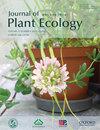Microbial Community Structure in rice rhizosheaths under drought stress
IF 3.9
2区 环境科学与生态学
Q2 ECOLOGY
引用次数: 1
Abstract
Rhizosheaths can form on the surface of rice (Oryza sativa L.) roots and improve the water use efficiency of rice under drought stress. The microbes in rhizosheaths can also offer the potential to increase the resilience of rice to future drought. However, little is known about the microbial community in rhizosheath of rice under drought stress. In this study, we compared the root traits, rhizosheath formation and microbial community in the rhizosheath under three irrigation regimes, including well-watered and drought treatments I and II. The irrigation plays important roles in influencing the microbial composition and co‑occurrence networks. Drought can promote the accumulation of beneficial microorganisms in rhizosheaths, such as bacteria that are members of the phylum Patescibacteria and the Massilia, Nocardioides, Frateuria, and Angustibacter genera and fungi in the genus Talaromyces. However, drought can also induce risk factors for harmful fungi in rice rhizosheaths. Our results suggest that both the rhizosheath and microbes in rhizosheath can offer the potential to improve the resistance of rice to drought. In the future, the isolation and application of beneficial microorganisms in rhizosheaths and scientific planting methods should be studied for the green cultivation of rice.干旱胁迫下水稻根鞘微生物群落结构
干旱胁迫下,水稻根系表面形成根鞘,提高水稻水分利用效率。根鞘中的微生物也有可能提高水稻对未来干旱的抵御能力。然而,对干旱胁迫下水稻根鞘微生物群落的研究却知之甚少。在本研究中,我们比较了三种灌溉方式下,包括丰水和干旱处理I和II,根性状、根鞘形成和根鞘微生物群落。灌溉对土壤微生物组成和共生网络有重要影响。干旱可以促进根鞘中有益微生物的积累,如Patescibacteria门的细菌和Massilia、Nocardioides、Frateuria和Angustibacter属的细菌以及Talaromyces属的真菌。然而,干旱也可以诱发水稻根鞘中有害真菌的危险因素。我们的研究结果表明,根鞘和根鞘中的微生物都具有提高水稻抗旱性的潜力。今后应进一步研究根茎有益微生物的分离与应用以及科学的种植方法,实现水稻的绿色栽培。
本文章由计算机程序翻译,如有差异,请以英文原文为准。
求助全文
约1分钟内获得全文
求助全文
来源期刊

Journal of Plant Ecology
生物-植物科学
CiteScore
4.60
自引率
18.50%
发文量
134
审稿时长
3 months
期刊介绍:
Journal of Plant Ecology (JPE) serves as an important medium for ecologists to present research findings and discuss challenging issues in the broad field of plants and their interactions with biotic and abiotic environment. The JPE will cover all aspects of plant ecology, including plant ecophysiology, population ecology, community ecology, ecosystem ecology and landscape ecology as well as conservation ecology, evolutionary ecology, and theoretical ecology.
 求助内容:
求助内容: 应助结果提醒方式:
应助结果提醒方式:


